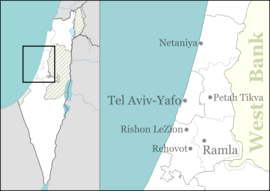Mazor
Mazor (Hebrew: מָזוֹר, lit. Cure) is a moshav in central Israel. Located in the Sharon plain around three kilometres south-east of Petah Tikva and covering 2,300 dunams, it falls under the jurisdiction of Hevel Modi'in Regional Council. In 2018 it had a population of 1,334.[1]
Mazor מָזוֹר | |
|---|---|
 Mazor  Mazor | |
| Coordinates: 32°3′9″N 34°55′33.95″E | |
| Country | Israel |
| District | Central |
| Council | Hevel Modi'in |
| Affiliation | Moshavim Movement |
| Founded | 1949 |
| Founded by | Jewish immigrants from Czechoslovakia and Hungary and native Jewish Israelis |
| Population (2018)[1] | 1,334 |

History
The moshav was established in 1949 by Jewish immigrants from Czechoslovakia and Hungary and by native-born Israelis. It was initially named Mizra Har (Hebrew: מזרע הר, lit. Sown Field on a Mountain), a name derived from the name of the nearby depopulated Arab village of Umm-Zara, more commonly known as al-Muzayri'a. The moshav was later renamed Mazor, Hebrew for Remedy, in honor of the medicinal herb factory established there[2] by the herbalist Mordechai Klein.[3] Mazor's early days form the subject of a work of historical fiction, Kfar BaSfar ("A Village on the Border") by Gershon Erich Steiner, one of Mazor's founders.[4]
Mazor was founded on land belonging both to the depopulated Palestinian village of Rantiya,[5] and the western land belonging to al-Muzayri'a.[6]
To the east of the moshav is an archaeological site, which includes a 3rd Century Roman mausoleum. The mausoleum is the only Roman era building in Israel to still stand from its foundations to its roof. A Byzantine-era mosaic floor was found not far from the mausoleum.
References
- "Population in the Localities 2018" (XLS). Israel Central Bureau of Statistics. 25 August 2019. Retrieved 26 August 2019.
- history page on the Mazor website
- Heb. article, "In the Grind of Medicinal Herbs", Davar 08.08.52., p.2.
- About Mazor Homee
- Khalidi, Walid (1992). All that Remains: The Palestinian Villages Occupied and Depopulated by Israel in 1948. Washington DC: Institute for Palestine Studies. p. 252. ISBN 0-88728-224-5.
- Khalidi, p399